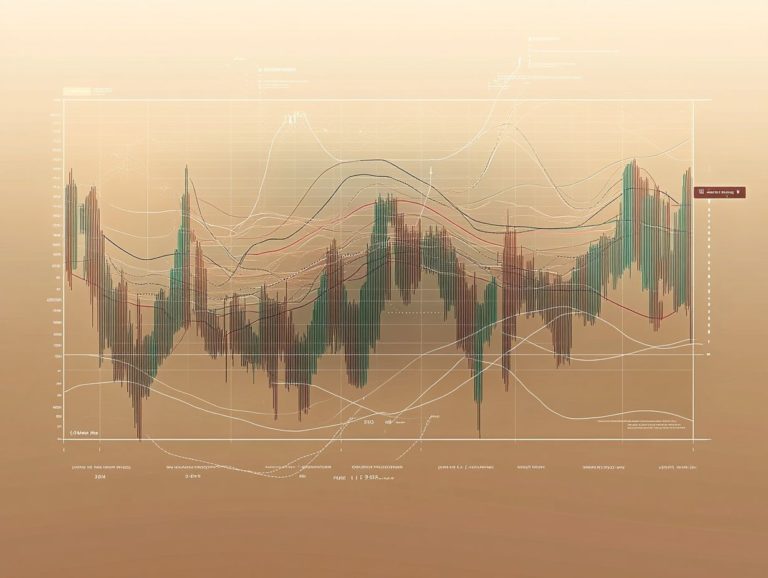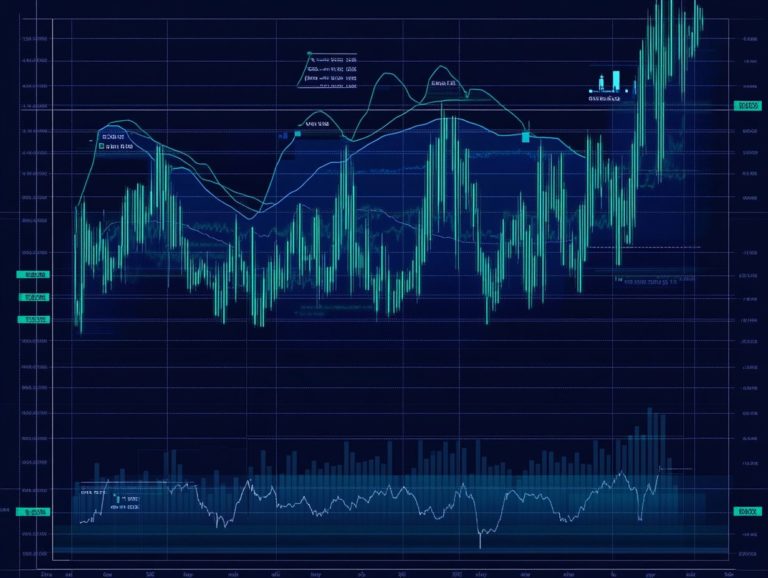The Power of Historical Data in Trading
In the fast-paced world of trading, grasping the past could be your golden ticket to future success.
Historical data serves as a treasure trove of insights into market trends. It allows you to identify patterns and make well-informed decisions. This discussion delves into the significance of historical data in trading and covers various types you can use, such as price and volume data. You’ll also learn how to access and analyze this information effectively.
By harnessing historical data, you can craft robust strategies and manage risks judiciously, setting the stage for more confident trading decisions.
Get ready to discover the power of historical data and its profound impact on your trading journey.
Contents
Key Takeaways:

- Historical data provides valuable insights into market trends and patterns, allowing traders to make informed predictions about future movements.
- Price, volume, and market sentiment data are commonly used in trading, providing a comprehensive view of market conditions.
- Accessing and analyzing historical data using reliable sources and tools can help traders create effective trading strategies and manage risks.
The Importance of Historical Data in Trading
Historical data is a cornerstone of effective trading in financial markets. It offers you critical insights into market dynamics, price movements, and trading patterns. By leveraging this data, you can analyze the market thoroughly and craft informed trading strategies that anticipate price trends and enhance your investment decisions, especially by understanding market trends through historical data.
A robust understanding of historical trends helps you gauge market sentiment and pinpoint key economic indicators that significantly influence trading outcomes. This knowledge ultimately fosters a competitive edge in a rapidly evolving market landscape.
What is Historical Data?
Historical data includes past information about market trends, price movements, and trading volume. This data is essential for understanding the performance of financial instruments over time.
This data serves as a critical resource for you as a trader or investor. It offers valuable insights into how specific assets have behaved under various market conditions. Analyzing price trends helps you predict future movements, while examining trading volume allows you to gauge the strength of those trends.
Different types of historical data like daily closing prices, intraday fluctuations, and notable volume spikes offer you a comprehensive view of market dynamics. The patterns you observe in this data can be instrumental in shaping your strategies, managing risks, and making informed decisions in the ever-evolving trading landscape.
Understanding Market Trends
Understanding market trends is essential for you as a trader. It equips you to interpret price movements and make informed decisions grounded in statistical analysis.
By diving into historical data, you’ll uncover patterns that reflect the collective behavior of market participants. This provides valuable insights into potential future movements. You might find yourself employing various technical indicators, such as moving averages and the Relative Strength Index (RSI), a tool to measure price momentum. This helps quantify these trends and pinpoint optimal entry or exit points.
Additionally, incorporating fundamental analysis taking into account economic factors and company performance offers a more holistic view of market dynamics. Ultimately, recognizing and adapting to these trends can significantly elevate your ability to navigate the complexities of the financial landscape.
Identifying Patterns and Predicting Future Movements
Identifying patterns in historical data is crucial for traders. These patterns provide insights into potential price changes.
By employing various analytical techniques, such as making predictions based on past data and examining trading patterns, you can supercharge your decision-making! Advanced tools allow you to sift through vast amounts of data, uncovering correlations and trends that may not be immediately visible.
Focusing on market predictions helps you evaluate previous price fluctuations and pinpoint recurring behaviors. This comprehensive approach aids in making informed predictions and gauging overall market sentiment. Ultimately, this leads to better trading decisions that can bolster your success in the market.
Types of Historical Data Used in Trading

In trading, you will encounter various types of historical data, such as price data, volume data, and market sentiment data. Each category provides distinct insights into market behavior, allowing for more informed decisions and strategies.
Price Data
Price data is essential, capturing the past prices of financial instruments over defined time frames. This information empowers you to identify potential market trends and evaluate asset volatility.
By scrutinizing patterns in price data, you can make informed decisions about when to enter or exit positions, shaping your overarching strategy. Analyzing historical price movements also allows you to backtest your theories and refine methods based on actual market behavior.
Leveraging price data effectively leads to a deeper understanding of market dynamics, enhancing your ability to navigate the ever-evolving financial landscapes with confidence.
Volume Data
Volume data represents the total number of shares or contracts traded for a specific financial instrument. It offers valuable insight into market dynamics and trading activity.
By analyzing this volume, you can gain a deeper understanding of potential price movements and the strength behind prevailing trends. High trading volumes typically indicate robust investor interest, suggesting a price move is likely to have greater stability.
Conversely, low volume may raise concerns about the reliability of a price trend. Volume serves as a confirming indicator; for example, a price increase alongside significant volume reinforces bullish sentiment, while declining prices with low volume might hint at a correction rather than a bearish trend continuation.
Market Sentiment Data
Market sentiment data reveals investors’ overall attitudes toward a specific market or financial instrument, significantly influencing trading decisions and market predictions.
This data is typically gathered through methods such as surveys, social media analysis, and observations of trading volumes, offering insights into consumer behavior. By understanding whether investors feel bullish or bearish, you can gauge potential market trends and shifts.
Insights from sentiment analytics play a crucial role in shaping your trading strategies, enabling anticipation of reactions to news events or economic indicators. Analyzing this sentiment empowers you to make more informed trading decisions, fostering a proactive approach to navigating financial markets.
How to Access and Analyze Historical Data
Accessing and analyzing historical data is essential for traders. There are various sources available, including market databases and advanced analytical tools designed to enhance your data visualization and interpretation skills.
Embracing these resources can significantly elevate your trading strategy and decision-making process.
Sources of Historical Data

You have many sources of historical data available, from financial markets to key economic indicators. These resources provide valuable insights into market behavior.
Explore online databases, brokerage platforms, and economic reports from government agencies. Platforms like Bloomberg and Yahoo Finance archive price history for stocks, commodities, and currencies.
Central banks and economic research institutions often release reports on past economic performance, inflation rates, and employment statistics.
Diving into this wealth of information helps you understand trends and cycles. This knowledge refines your decision-making in the dynamic financial landscape.
Tools and Techniques for Analysis
You have access to various tools for analyzing historical data, from basic statistics to advanced AI-driven tools. These options let you gain deeper insights into your data.
Statistical methods like regression analysis and time series forecasting help you identify patterns over time. Visualization tools like Tableau and Power BI transform complex datasets into easy-to-read graphs.
Combining analytical approaches with AI technologies streamlines your data processing. This helps you uncover subtle insights for better decision-making.
Using Historical Data to Inform Trading Decisions
Using historical data can guide your trading decisions. It enables you to craft data-driven strategies, assess risks accurately, and evaluate promotional tactics.
Creating Trading Strategies based on Historical Data
Building effective trading strategies requires careful trend analysis. This helps you optimize portfolio management and improve trading outcomes.
By examining past market behavior, you can spot patterns that may re-emerge. This historical analysis reveals periods of volatility and stability.
These insights allow you to create robust strategies that anticipate market shifts. This minimizes risk and maximizes returns, leading to disciplined trading decisions.
Risk Management and Mitigation
Risk management is essential for your trading strategy. Understanding historical risks helps you navigate potential pitfalls more easily.
Analyzing patterns from past market behavior prepares you for fluctuations. This strategic approach sharpens your ability to pinpoint potential losses and fosters a disciplined trading mindset.
Using historical data lets you set quantifiable performance benchmarks. This helps you craft resilient trading strategies suited to current market conditions.
With diligent risk assessment, you can seize opportunities while protecting your investments from unexpected challenges.
Frequently Asked Questions

What is the power of historical data in trading?
The power of historical data in trading lies in its ability to provide insights into past market trends and behaviors. This helps inform future trading strategies. By looking at the role of historical data in risk management, traders can identify patterns and make informed decisions.
How can historical data be used in trading?
There are many ways to use historical data in trading:
- Backtesting trading strategies
- Identifying market trends and patterns
- Making informed decisions based on past market behavior
Why is historical data important in trading?
Historical data is crucial because it provides a way to understand market behavior. Without it, traders would operate blindly, lacking knowledge of past trends.
Can historical data predict future market movements?
While historical data cannot predict future market movements with 100% accuracy, it offers valuable insights. Remember, past performance does not guarantee future results.
Where can traders find historical data for trading?
Traders can easily find historical data from several sources, including:
- Financial websites
- Trading platforms
- Data providers
It’s important to ensure that the data is reliable and accurate before using it for trading purposes.
How often should traders use historical data for trading?
Traders should regularly use historical data, as it provides valuable insights into market trends. It’s also crucial to consider current market conditions and not rely solely on historical data for trading decisions.





